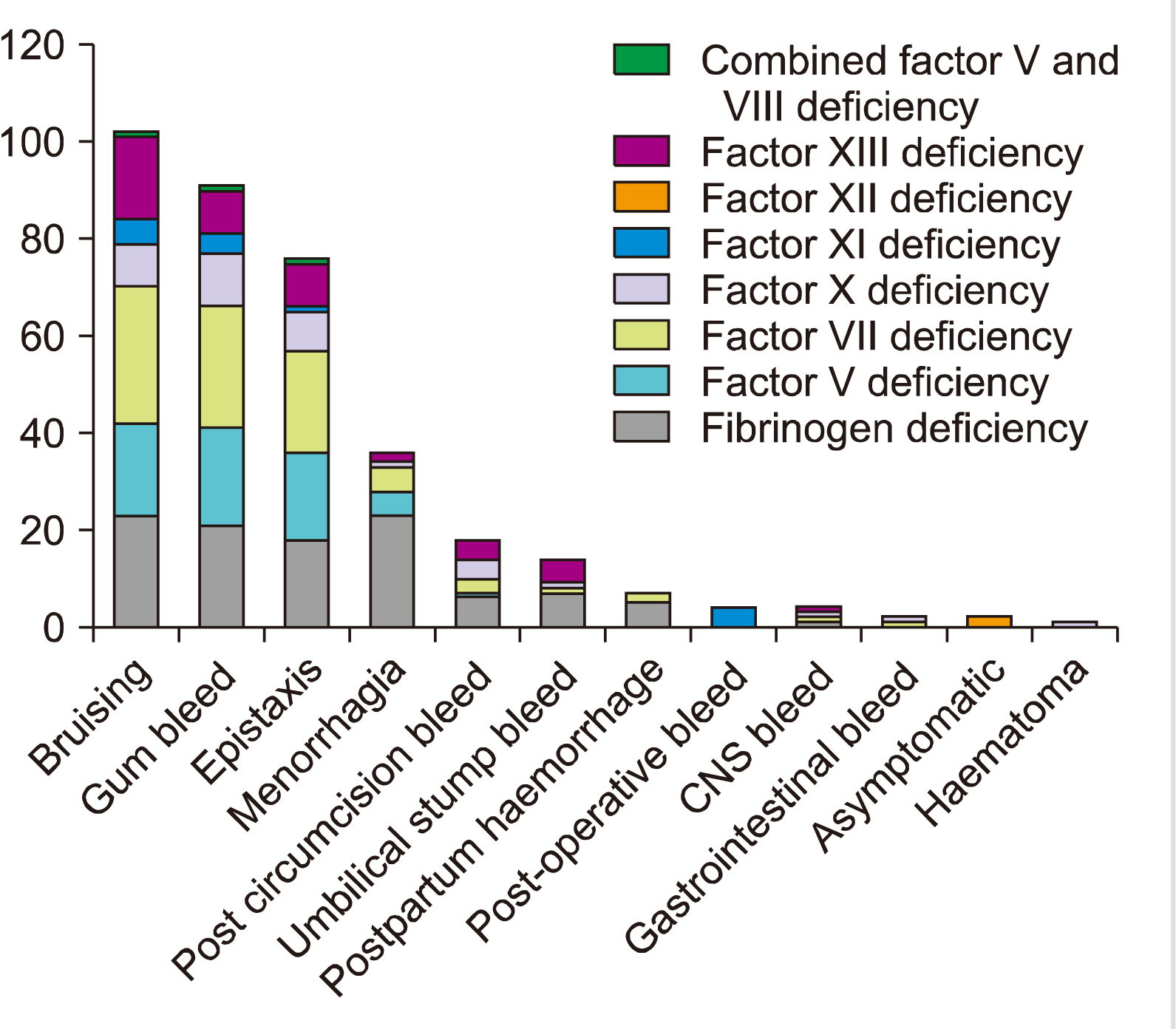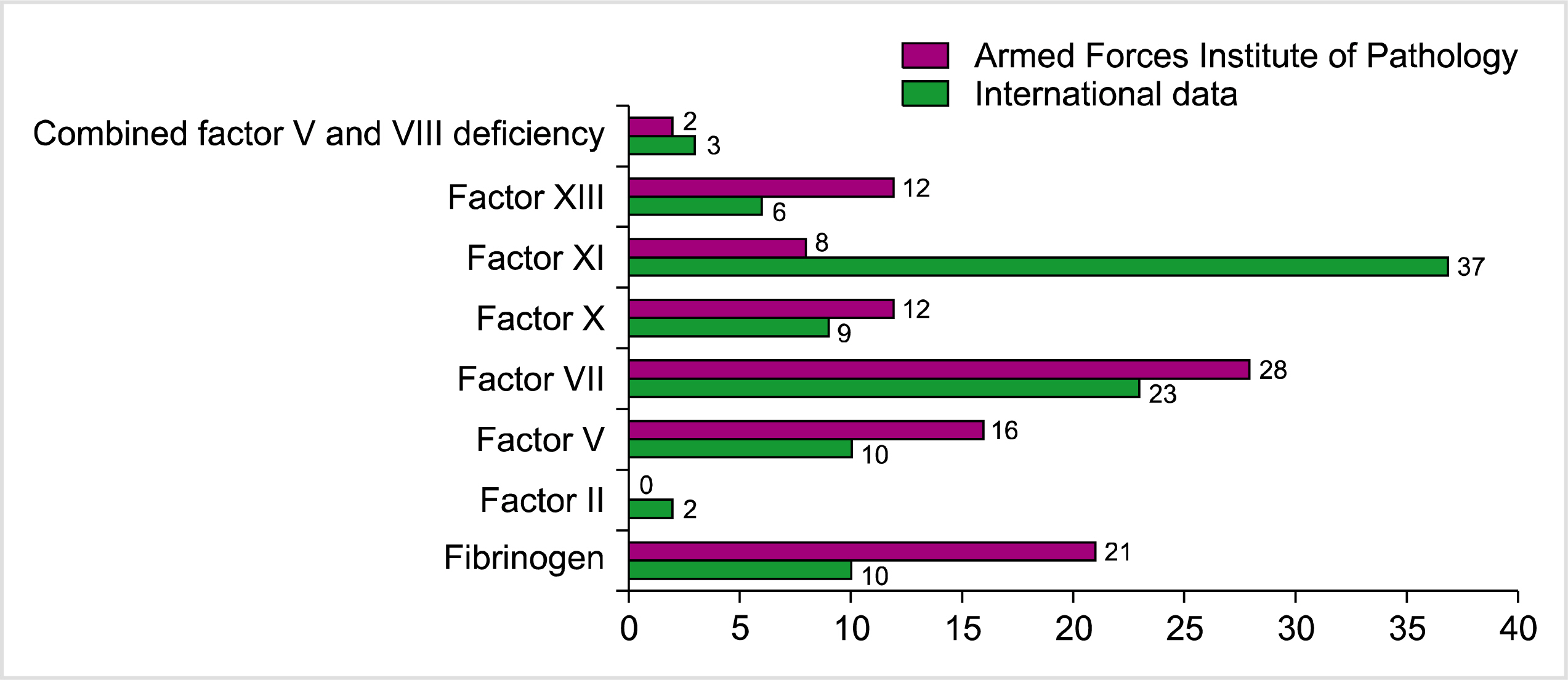Blood Res.
2020 Sep;55(3):146-150. 10.5045/br.2020.2020035.
Rare bleeding disorders: spectrum of disease and clinical manifestations in the Pakistani population
- Affiliations
-
- 1Department of Haematology, Armed Forces Institute of Pathology, Rawalpindi, Pakistan
- KMID: 2507054
- DOI: http://doi.org/10.5045/br.2020.2020035
Abstract
- Background
Rare inherited coagulation factor deficiencies constitute an important group of bleeding disorders. A higher frequency of these disorders is seen in areas of high consanguinity. Our aim was to study the prevalence and spectrum of rare inherited bleeding disorders, characterize the severity of the deficiencies, identify different clinical manifestations, and evaluate different treatments provided.
Methods
This cross-sectional study was conducted in the Department of Haematology, Armed Forces Institute of Pathology Rawalpindi, between January 2014 and December 2018. A detailed history was taken, and an examination was performed. The signs and symptoms were noted, and the patients were diagnosed on the basis of a coagulation profile. The disease severity was assessed using factor assays.
Results
Among 2,516 patients with suspected coagulation disorders, 774 (30.8%) had an inherited bleeding disorder. Of the 774 patients, 165 (21.3%) had a rare bleeding disorder; 91 (55.2%) of them were males, and 74 (44.9%) were females, with a male-to-female ratio of 1.2:1. The median patient age was 9 years 3 months. The most common disorder was factor VII deficiency (46 patients, 27.9%). The most common clinical presentation was bruising in 102 (61.8%) and gum bleeding in 91 (55.2%) patients.
Conclusion
The most common rare bleeding disorder in our population is factor VII deficiency. The prevalence of these bleeding disorders is high in our population due to a high number of consanguineous marriages.
Figure
Reference
-
1. Palla R, Peyvandi F, Shapiro AD. 2015; Rare bleeding disorders: diagnosis and treatment. Blood. 125:2052–61. DOI: 10.1182/blood-2014-08-532820. PMID: 25712993.
Article2. Naderi M, Tabibian S, Hosseini MS, et al. 2014; Rare bleeding disorders: a narrative review of epidemiology, molecular and clinical presentations, diagnosis and treatment. JPR. 2:31–46.3. Peyvandi F, Palla R, Menegatti M, et al. 2012; Coagulation factor activity and clinical bleeding severity in rare bleeding disorders: results from the European Network of Rare Bleeding Disorders. J Thromb Haemost. 10:615–21. DOI: 10.1111/j.1538-7836.2012.04653.x. PMID: 22321862.
Article4. Dorgalaleh A, Alavi SE, Tabibian S, et al. 2017; Diagnosis, clinical manifestations and management of rare bleeding disorders in Iran. Hematology. 22:224–30. DOI: 10.1080/10245332.2016.1263007. PMID: 27894217.
Article5. Öner N, Gürsel T, Kaya Z, et al. 2020; Inherited coagulation disorders in Turkish children: a retrospective, single-center cohort study. Transfus Apher Sci. 59:102728. DOI: 10.1016/j.transci.2020.102728. PMID: 31980335.
Article6. de Moerloose P, Schved JF, Nugent D. 2016; Rare coagulation disorders: fibrinogen, factor VII and factor XIII. Haemophilia. 22(Suppl 5):61–5. DOI: 10.1111/hae.12965. PMID: 27405678.
Article7. Acharya SS, Coughlin A, Dimichele DM. North American Rare Bleeding Disorder Study Group. 2004; Rare bleeding disorder registry: deficiencies of factors II, V, VII, X, XIII, fibrinogen and dysfibrinogenemias. J Thromb Haemost. 2:248–56. DOI: 10.1111/j.1538-7836.2003.t01-1-00553.x. PMID: 14995986.
Article8. Mumford AD, Ackroyd S, Alikhan R, et al. 2014; Guideline for the diagnosis and management of the rare coagulation disorders: a United Kingdom Haemophilia Centre Doctors' Organization guideline on behalf of the British Committee for Standards in Haematology. Br J Haematol. 167:304–26. DOI: 10.1111/bjh.13058.9. Peyvandi F, Di Michele D, Bolton-Maggs PH, et al. 2012; Classification of rare bleeding disorders (RBDs) based on the association between coagulant factor activity and clinical bleeding severity. J Thromb Haemost. 10:1938–43. DOI: 10.1111/j.1538-7836.2012.04844.x. PMID: 22943259.
Article10. Colvin BT, Astermark J, Fischer K, et al. 2008; European principles of haemophilia care. Haemophilia. 14:361–74. DOI: 10.1111/j.1365-2516.2007.01625.x. PMID: 18248408.
Article11. Jain S, Acharya SS. 2018; Management of rare coagulation disorders in 2018. Transfus Apher Sci. 57:705–12. DOI: 10.1016/j.transci.2018.10.009. PMID: 30392819.
Article12. Peyvandi F, Garagiola I, Biguzzi E. 2016; Advances in the treatment of bleeding disorders. J Thromb Haemost. 14:2095–106. DOI: 10.1111/jth.13491. PMID: 27590165.
Article13. Mansouritorghabeh H, Manavifar L, Banihashem A, et al. 2013; An investigation of the spectrum of common and rare inherited coagulation disorders in north-eastern Iran. Blood Transfus. 11:233–40. DOI: 10.2450/2012.0023-12. PMID: 23114518. PMCID: PMC3626474.14. Farjami A, Haghpanah S, Arasteh P, et al. 2017; Epidemiology of hereditary coagulation bleeding disorders: a 15-year experience from Southern Iran. Hospital Practices and Research. 2:113–7. DOI: 10.15171/hpr.2017.27.
Article15. Sharma SK, Kumar S, Seth T, et al. 2012; Clinical profile of patients with rare inherited coagulation disorders: a retrospective analysis of 67 patients from northern India. Mediterr J Hematol Infect Dis. 4:e2012057. DOI: 10.4084/mjhid.2012.057. PMID: 23170186. PMCID: PMC3499996.
Article16. Fışgın T, Balkan C, Celkan T, et al. 2012; Rare coagulation disorders: a retrospective analysis of 156 patients in Turkey. Turk J Haematol. 29:48–54. DOI: 10.5505/tjh.2012.02418. PMID: 24744623. PMCID: PMC3986768.17. Jaouad IC, Elalaoui SC, Sbiti A, Elkerh F, Belmahi L, Sefiani A. 2009; Consanguineous marriages in Morocco and the consequence for the incidence of autosomal recessive disorders. J Biosoc Sci. 41:575–81. DOI: 10.1017/S0021932009003393. PMID: 19433002.
Article18. Şalcıoğlu Z, Bayram C, Şen H, et al. 2018; Congenital factor deficiencies in children: a report of a single-center experience. Clin Appl Thromb Hemost. 24:901–7. DOI: 10.1177/1076029617731596. PMID: 29050499. PMCID: PMC6714728.
Article19. Peyvandi F, Kaufman RJ, Seligsohn U, et al. 2006; Rare bleeding disorders. Haemophilia. 12(Suppl 3):137–42. DOI: 10.1111/j.1365-2516.2006.01271.x. PMID: 30392819.
Article
- Full Text Links
- Actions
-
Cited
- CITED
-
- Close
- Share
- Similar articles
-
- Genome-Wide Supported Risk Variants in MIR137, CACNA1C, CSMD1, DRD2, and GRM3 Contribute to Schizophrenia Susceptibility in Pakistani Population
- Lumbar Morphometry: A Study of Lumbar Vertebrae from a Pakistani Population Using Computed Tomography Scans
- Mining of mortality-related findings in rare bleeding disorders: a retrospective study from two centers
- Aripiprazole Improved Obsessive Compulsive Symptoms in Asperger's Disorder
- Association study of the angiotensin-converting enzyme (ACE) gene G2350A dimorphism with myocardial infarction



